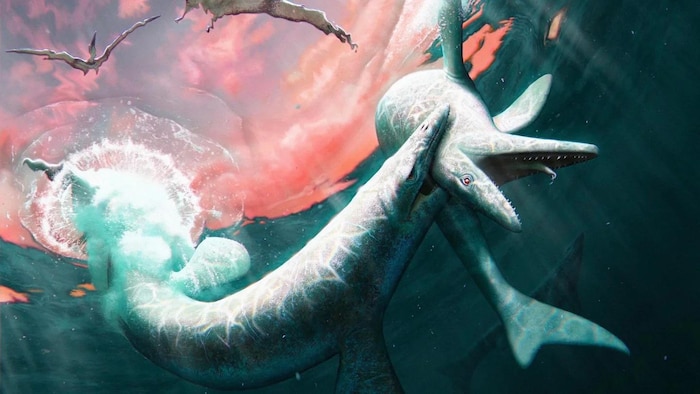Open in full screen mode Two Jormungandr walhallaensis fighting. (Artistic illustration) Radio-Canada Feature being tested Log inCreate my account Speech synthesis, based on artificial intelligence, allows you to generate a spoken text from a written text. Fossilized remains discovered in 2015 in the Pierre Shale formation in North Dakota, United States, belong to a species of an unknown genus of mosasaurs that lived there about 80 million years ago. Named Jormungandr walhallaensis, the species name refers to a snake sea of Nordic mythology, the Jormungandr, and to the small North Dakota town of Walhalla, near where the fossil was discovered. This fossil comes from an American geological era that we don't really understand, says paleontologist Clint Boyd of the North Dakota Geological Survey. The fossilized remains include a skull and part of the skeleton corresponding to its cervical spine and several vertebrae.
Drawing of the skull of Jormungandr walhallaensis.
The beast, whose skull measured 72 centimeters and body more than 7 meters long, presented transitional features placing it between two other known mosasaur species.
According to paleontologist Amelia Zietlow, lead author of the study published in the Bulletin of the American Museum of Natural History (New window) (in English), Jormungandr walhallaensis em> was most likely a precursor of Mosasaurus.
It's like adding fins to a giant Komodo dragon, explains the paleontologist in a press release
The first mosasaur fossils, two skulls, were discovered in 1764 in a quarry near Maastricht, in the Netherlands.
Reconstructed skeleton of Mosasaurus hoffmannii, on display at the Natural History Museum in Maastricht, the Netherlands.
The interpretation of the fossilized remains of the large animal from Maastricht was highly debated among scientists of the time. In the late 18th century, naturalist Georges Cuvier described the animal as a large marine reptile sharing similarities with monitor lizards, but unlike any known living animal.
It was not until 1822 that a name was given to the creature. Paleontologist William Conybeare named the animal Mosasaurus, which literally means Meuse lizard, in reference to its discovery made near the river of the same name. The exact affinities of Mosasaurus as a squamate, a term that refers to the covering of the body with scales, remain controversial, and scientists continue to debate whether its closest living relatives are monitor lizards or snakes.
Today, paleontologists are still trying to determine the relationships between different groups of mosasaurs. The present work brings a new piece to the puzzles, say the authors.
After 200 years of scientific study, unknown species of mosasaur are still being discovered as new regions are explored and specimens collected long ago are reevaluated with current species classification standards, the authors note.
But several questions remain unanswered. How many times did these animals evolve to develop fins and when did they become fully aquatic?
As these animals evolved to become giant sea monsters, they were constantly changing, explains Amelia Zietlow. Our work brings us a little closer to understanding the links between these different forms.

